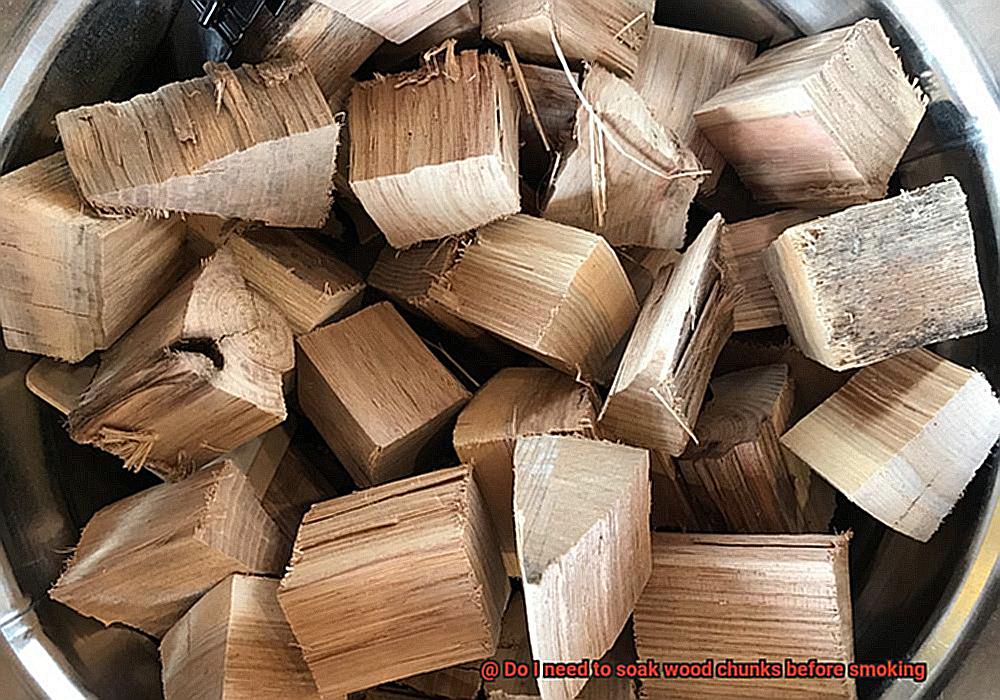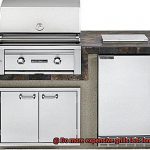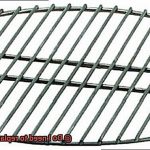Imagine this: a lazy afternoon with your loved ones, the tantalizing scent of sizzling meat wafting through the air, and the excitement of a perfectly smoked meal. As grilling and smoking enthusiasts, we all strive for that delicate balance of flavor and tenderness. But here’s the burning question: should you soak your wood chunks before firing up the smoker?
In the world of smoking, opinions are as diverse as the flavors we seek to create. Some swear by soaking their wood chunks, while others dismiss it as an unnecessary step. Today, we’re delving into this ongoing debate, exploring the potential benefits and drawbacks of soaking wood chunks before igniting that BBQ pit.
Join us as we separate fact from fiction and arm you with the knowledge to make an informed decision. Whether you’re a seasoned pitmaster or a backyard enthusiast, let’s uncover the truth behind this age-old practice and whether it truly elevates your smoking game.
Contents
Pros and Cons of Soaking Wood Chunks
Here are some advantages and disadvantages to help you make an informed decision:
Advantages of Soaking Wood Chunks:
- Prolongs the smoking process: Soaking wood chunks helps them burn slower, releasing smoke for a longer period of time. This is beneficial for smoking larger cuts of meat that require a longer cooking time.
- Reduces flare-ups: Saturating the wood with water makes it more difficult to catch fire quickly, reducing the risk of flare-ups and burnt food. This is particularly useful for grilling beginners who may struggle with fire control.
- Adds moisture to the cooking environment: Soaked wood chunks release water vapor slowly during smoking, creating a moist and flavorful cooking environment. This can help prevent meats from drying out.
Disadvantages of Soaking Wood Chunks:
- Diminished smoke flavor: Soaked wood may produce less smoke flavor compared to dry wood. The water absorbed by the wood dilutes the natural oils and resins responsible for aromatic smoke flavors.
- Prolongs cooking time: Wet wood takes longer to ignite and burn than dry wood, potentially increasing the cooking time. This may be problematic if you’re pressed for time or prefer a quicker smoking experience.
- Unnecessary for certain types of wood: Some hardwoods, like hickory and mesquite, are naturally dense and do not readily absorb water. Soaking these types of wood may have little to no effect on burn time or smoke production.
- Potential waste of time and resources: Some grillers argue that soaking wood chunks is unnecessary and can be seen as a waste of time and resources. They believe that properly seasoned dry wood can achieve the same results without soaking.
Exploring the Benefits of Soaking Wood Chunks
Soaking wood chunks before smoking can have several benefits that enhance your grilling experience. Let’s dive deeper into these advantages:
- Slower combustion: Dry wood chunks tend to burn quickly, resulting in a shorter smoking time. Soaking the wood introduces moisture, which slows down the combustion process. This allows for a more controlled and prolonged smoke, giving you more time to infuse your food with that delicious smoky flavor.
- Enhanced flavor infusion: When wood chunks are soaked, they release steam as they heat up during smoking. This steam carries aromatic compounds present in the wood, such as lignin and cellulose, which contribute to the overall flavor profile of the smoked food. Soaking the wood helps infuse these flavors into your meat or vegetables, adding depth and complexity to your dishes.
- Temperature regulation: Soaked wood chunks create a moist environment as they release steam. This helps regulate the temperature inside the smoker, ensuring a steady heat throughout the smoking process. This is particularly beneficial for longer smoking sessions or when using a charcoal smoker, as it prevents rapid temperature fluctuations that can affect the quality of the smoke.
Reduced chances of flare-ups and excessive smoke production: Dry wood is more prone to catching fire or producing excessive smoke when exposed to high heat. Soaking the wood keeps it damp and less likely to flare up, reducing the risk of unpleasant flavors on your food. It also helps create a smoother smoking experience by minimizing excessive smoke production.
The Drawbacks of Soaking Wood Chunks
Soaking wood chunks before smoking may seem like a great idea for enhancing the flavor of your grilled dishes, but there are several drawbacks to consider.
Firstly, soaking wood chunks can actually result in less smoke and flavor during the smoking process. When wood is soaked, it absorbs water, which then needs to evaporate before the wood can start producing smoke. This means that it takes longer for the wood to start smoking, and the overall amount of smoke produced may be reduced. So, if you’re looking for a strong smoky flavor, soaking the wood chunks may not be the best option.
Additionally, soaking wood chunks can lead to inconsistent temperatures while smoking. The moisture in the soaked wood can create steam when it comes into contact with the heat source, causing fluctuations in temperature inside the smoker. This can make it difficult to maintain a steady cooking temperature and can negatively impact the outcome of your smoked food.
Furthermore, soaking wood chunks can increase the cooking time. As mentioned earlier, soaked wood takes longer to produce smoke, which means that it will take longer for your food to cook. This can be particularly inconvenient if you are trying to smoke larger cuts of meat that require longer cooking times.
Another drawback is that soaking wood chunks can affect the overall flavor profile of your smoked food. The water that is absorbed by the wood can dilute the natural flavors of the wood itself, resulting in a milder smoke flavor. This may not be desirable for those who enjoy a robust and intense smoky taste in their grilled dishes.
Lastly, soaking wood chunks can be a time-consuming process. Depending on the size of the wood chunks, they may need to soak for several hours or even overnight before they are ready for use. This additional step adds to the preparation time and may not be practical for those who are looking for a quick and convenient grilling experience.
Different Methods for Soaking Wood Chunks
While the previous section argued against soaking wood chunks, it’s important to acknowledge that some grillers still prefer to soak their wood before smoking. If you’re one of those grillers who enjoy the process of soaking and experimenting with different flavors, here are some methods you can try:
Submerging in Water:
The most common method is to simply submerge the wood chunks in water. This method is straightforward and easy to do. Soaking times can vary depending on the size of the wood chunks, but a general guideline is to soak them for 30 minutes to 24 hours. Remember to fully drain the chunks before placing them on the grill to avoid excess moisture.
Infusing with Other Liquids:
For those looking to add a unique flavor profile to their smoked meat, soaking wood chunks in liquids such as beer, wine, or fruit juice can be a fun option. This method infuses the wood with different flavors, enhancing the taste of the final product. For example, soaking wood in apple juice can impart a subtle sweetness to your smoked dishes.
Brine Soaking:
Some grillers swear by soaking wood chunks in a brine solution made by dissolving salt in water. The salt helps draw out impurities from the wood and enhances the overall flavor of the smoke. This method is particularly popular for smoking seafood, as it adds an extra layer of seasoning.
Wrapping in Foil:
To retain moisture and prevent the wood from drying out too quickly during the smoking process, some enthusiasts recommend wrapping soaked wood chunks in aluminum foil before placing them on the grill. This method helps create a more controlled environment for the wood chunks and can result in a longer burn time.
Remember, while these soaking methods can add flavor and moisture to your smoked dishes, they are not necessary for successful grilling. It’s a matter of personal preference and experimentation. If you choose to soak your wood chunks, make sure to fully drain them before using them on the grill to avoid unwanted flare-ups and uneven burning.
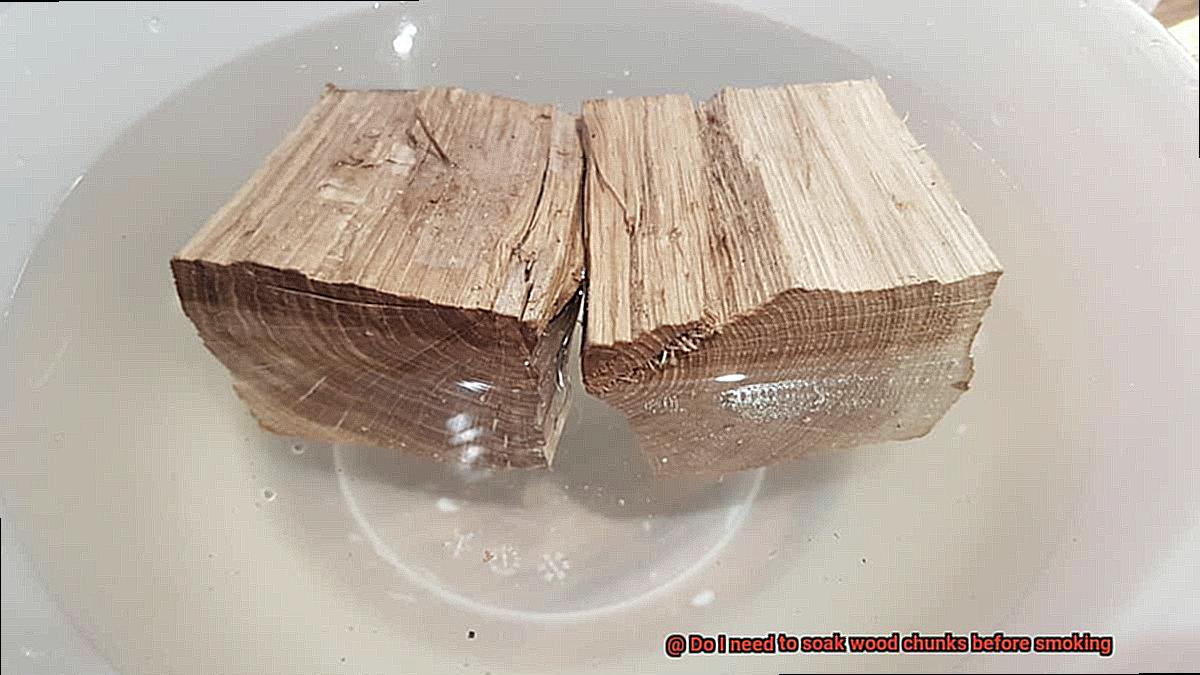
Additionally, it’s worth mentioning that soaking wood chips, which are smaller and thinner than wood chunks, is more common and often recommended. The smaller size of the chips allows them to absorb moisture more effectively, resulting in a longer burn time and a more consistent smoke. Soaking wood chips for 15-30 minutes is generally sufficient.
Avoiding Common Mistakes When Soaking Wood Chunks
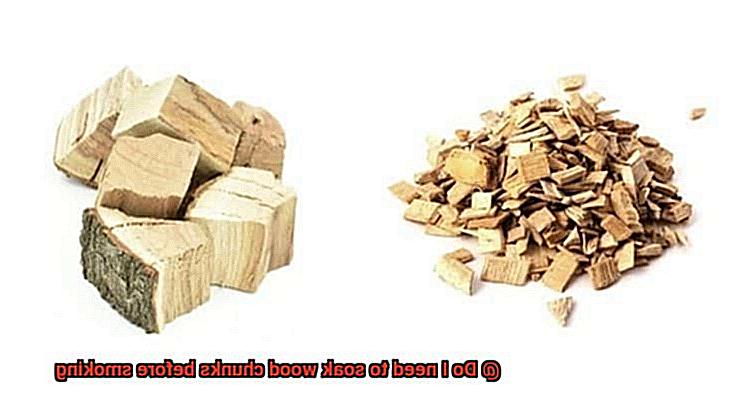
Soaking wood chunks before smoking can elevate your grilling experience by infusing your food with delicious smoky flavors. However, there are some common mistakes that can hinder the outcome. To ensure you get the most out of your wood chunks, here are some important tips to avoid these pitfalls:
- Don’t soak the wood for too long: While soaking is essential, leaving the wood chunks submerged for an extended period can actually diminish their natural flavors. Aim to soak them for around 30 minutes to an hour, allowing enough time for moisture absorption without compromising flavor.
- Use the right type of water: Tap water may contain chemicals like chlorine that can affect the taste of the wood and ultimately your food. Opt for filtered or distilled water to ensure a clean and pure infusion of flavors.
- Avoid soaking in hot water: While it may seem tempting to speed up the soaking process, hot water can release bitter compounds from the wood, resulting in an unwanted taste. Stick to cold or room temperature water for a more balanced and flavorful outcome.
- Don’t overdo the water: The goal is to moisten the wood, not drown it. Using excess water can prolong drying times and make it difficult for the wood to ignite properly during smoking. Use just enough water to achieve the desired level of moisture.
- Start with dry wood chunks: Never soak wood chunks that are already damp or wet. Wet wood takes longer to dry and can produce excessive steam during smoking, altering the flavor and texture of your food. Begin with dry wood and only soak them as needed.
Tips to Maximize Flavor when Smoking with Soaked Wood Chunks
To truly maximize the flavor when smoking with soaked wood chunks, it is crucial to select the right type of wood. Each type of wood imparts its own distinct flavor profile that can enhance specific types of meat or vegetables. For example, hickory wood adds a strong and smoky flavor that pairs exceptionally well with pork, while fruitwoods like apple or cherry can bring a subtle sweetness to poultry or fish. By experimenting with different types of wood, you can discover the perfect flavor combination for your desired dish.
Soak the Wood Chunks for an Adequate Amount of Time
Soaking the wood chunks for an adequate amount of time is essential for maximizing flavor. The recommended soaking time is at least 30 minutes before using them in the smoker. This allows the chunks to absorb enough water to create steam when heated, resulting in a more flavorful smoke. However, it is important not to soak the wood for too long as excessive moisture can weaken the smoke flavor.
Properly Prepare the Wood Chunks
Before soaking the wood chunks, it is crucial to properly prepare them by removing any bark or debris. Bark and debris can produce unwanted flavors or bitterness in the smoke. Additionally, consider cutting the chunks into smaller pieces or using wood chips instead of large chunks. This ensures a more even distribution of smoke and flavor throughout the cooking process.
Control Temperature and Airflow
To maximize flavor, it is crucial to control the temperature and airflow in the smoker. Maintaining a consistent temperature within the ideal range of 225°F to 250°F (107°C to 121°C) ensures that the soaked wood chunks produce a steady stream of flavorful smoke throughout the cooking process. Proper airflow allows for optimal combustion and smoke production.
Be Patient
Patience is key when smoking with soaked wood chunks. The flavors of the smoke take time to infuse into the food, so it is important to allow enough cooking time for them to develop fully. This may mean cooking at a lower temperature for a longer period, but the end result will be a more flavorful and delicious dish.
How to Ensure Proper Temperatures When Smoking with Soaked Wood Chunks
When it comes to smoking meats and achieving that delicious smoky flavor, maintaining proper temperatures is key. Here are some tips to ensure proper temperatures when using soaked wood chunks:
Preheat your smoker
Before adding the soaked wood chunks, preheat your smoker to the desired temperature. This step is crucial in ensuring a consistent heat throughout the smoking process. By starting with a well-insulated smoker, you can prevent temperature fluctuations that could affect the overall cooking time and result in unevenly cooked food.
Monitor the temperature
To ensure proper temperatures, use a reliable thermometer to monitor the temperature inside the smoker. It’s important to keep the temperature within the recommended range for your specific type of meat. Adjust the vents or dampers on your smoker to control the airflow and maintain a consistent temperature. Remember, opening the vents will increase oxygen flow and raise the temperature, while closing them will reduce oxygen flow and lower the temperature.
Control smoke production
Pay close attention to the amount of smoke produced by the soaked wood chunks. Too much smoke can give your meat a bitter taste, so it’s crucial to find a balance. If you notice excessive smoke, you can adjust the position of the wood chunks or soak them for a shorter period of time to reduce smoke production. Remember, soaking wood chunks before smoking helps regulate temperature and prevents them from burning too quickly.
Experiment with different wood types
Different types of wood will burn at different rates and produce varying levels of heat. It’s worth experimenting with various types of soaked wood chunks to find what works best for your smoking preferences. Some woods, like hickory or mesquite, provide strong flavors, while others, like fruit woods or oak, offer milder flavors.
Maintain a consistent heat source
Throughout the smoking process, make sure to add more soaked wood chunks as needed to keep the temperature steady. This will ensure a flavorful outcome and prevent temperature fluctuations. Remember to drain off any excess water from the soaked wood chunks before placing them in the smoker to avoid temperature spikes caused by dripping water into the firebox.
Alternatives to Soaking Wood Chunks
It’s believed to enhance the smoky flavor and prevent the wood from burning too quickly. However, there are alternatives to soaking wood chunks that can still yield excellent results.
One alternative is using dry wood chunks. Dry wood chunks can be used directly in the smoker without any soaking. This method is preferred by those who want a stronger and more intense smoky flavor in their food. The dry wood chunks burn faster, so it’s important to monitor the temperature and adjust accordingly to prevent over-smoking.
Another alternative is using wood chips instead of wood chunks. Wood chips are smaller in size and can be added directly to the charcoal or placed in a smoker box. They ignite quickly and release smoke faster than wood chunks, giving your food a smoky flavor in a shorter amount of time. You can experiment with various flavors like apple, hickory, mesquite, and cherry to find your preferred taste.
If you prefer using wood chunks but don’t want to soak them, try using a water pan in your smoker. Place a water pan filled with hot water beneath the meat to maintain moisture and prevent the wood from burning too quickly. The steam generated from the water pan adds an extra layer of flavor to your food.
Another alternative is the spritzing or mopping technique. Periodically spray or brush a liquid onto the meat while it’s cooking. A mixture of water, vinegar, apple juice, or any other flavorful liquid creates a barrier between the wood and the meat, preventing it from drying out and adding subtle flavors.
Lastly, consider using pre-seasoned or flavored wood chunks. These infused wood chunks eliminate the need for soaking and add an extra layer of flavor to your food without any additional effort.
4IyrDtIydh4″ >
Conclusion
In conclusion, the debate rages on: to soak or not to soak wood chunks before smoking? Among grilling and smoking enthusiasts, this question sparks fiery discussions. But ultimately, the decision rests in your hands, as personal preference and experimentation take center stage.
Soaking wood chunks can offer a host of advantages. It prolongs the smoking process, taming the flames and reducing those pesky flare-ups that can ruin a perfectly good cookout. Plus, it adds moisture to the cooking environment, ensuring your meats stay succulent and juicy. However, there are drawbacks to consider as well. Soaking can diminish the smoky flavor you crave, extend cooking times unnecessarily, and prove unnecessary for certain types of wood.
If you do opt for soaking your wood chunks, tread carefully. There’s an art to it that demands attention to detail. Avoid leaving your precious timber submerged for too long; a quick dip will suffice. And don’t forget about using the right type of water – no hot water baths here. Overdoing it with excessive water is a common mistake best avoided. Lastly, start with dry wood chunks; they’ll absorb just enough moisture without becoming waterlogged.
But fear not if soaking doesn’t float your boat. There are alternatives aplenty that can still yield mouthwatering results. For a robust smoky flavor that packs a punch, dry wood chunks are your go-to option. If time is of the essence (and let’s face it – when isn’t it?), wood chips provide quick smoke production without sacrificing taste. And if moisture control is what you seek, employing a trusty water pan will keep things just right. Or why not try spritzing or mopping techniques for an extra burst of flavor and moisture? And let’s not forget pre-seasoned or flavored wood chunks – they’re ready to rock from the get-go.
Ultimately, the choice lies firmly in your hands – or rather, in your smoker. Whether you choose to soak your wood chunks or embark on a journey of alternative methods, remember that smoking is an art form. It’s a chance to unleash your creativity and indulge in deliciously smoked meals.

